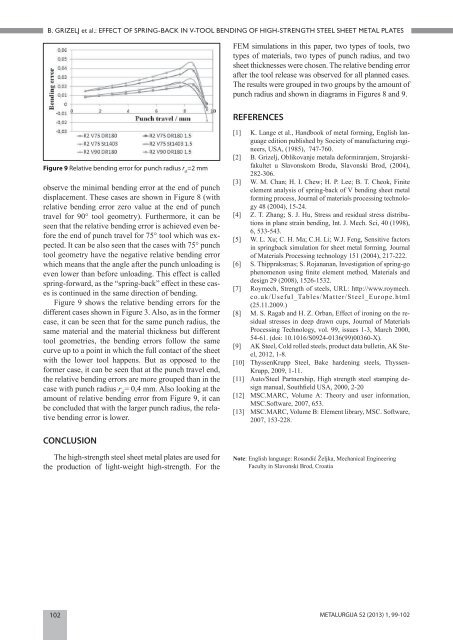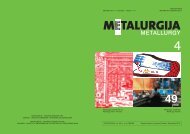Metalurgija: sadašnjost Metallurgy: Present Metalurgija ... - CARNet
Metalurgija: sadašnjost Metallurgy: Present Metalurgija ... - CARNet
Metalurgija: sadašnjost Metallurgy: Present Metalurgija ... - CARNet
Create successful ePaper yourself
Turn your PDF publications into a flip-book with our unique Google optimized e-Paper software.
B. GRIZELJ et al.: EFFECT OF SPRING-BACK IN V-TOOL BENDING OF HIGH-STRENGTH STEEL SHEET METAL PLATES<br />
Figure 9 Relative bending error for punch radius r st =2 mm<br />
observe the minimal bending error at the end of punch<br />
displacement. These cases are shown in Figure 8 (with<br />
relative bending error zero value at the end of punch<br />
travel for 90° tool geometry). Furthermore, it can be<br />
seen that the relative bending error is achieved even before<br />
the end of punch travel for 75° tool which was expected.<br />
It can be also seen that the cases with 75° punch<br />
tool geometry have the negative relative bending error<br />
which means that the angle after the punch unloading is<br />
even lower than before unloading. This effect is called<br />
spring-forward, as the “spring-back” effect in these cases<br />
is continued in the same direction of bending.<br />
Figure 9 shows the relative bending errors for the<br />
different cases shown in Figure 3. Also, as in the former<br />
case, it can be seen that for the same punch radius, the<br />
same material and the material thickness but different<br />
tool geometries, the bending errors follow the same<br />
curve up to a point in which the full contact of the sheet<br />
with the lower tool happens. But as opposed to the<br />
former case, it can be seen that at the punch travel end,<br />
the relative bending errors are more grouped than in the<br />
case with punch radius r st = 0,4 mm. Also looking at the<br />
amount of relative bending error from Figure 9, it can<br />
be concluded that with the larger punch radius, the relative<br />
bending error is lower.<br />
CONCLUSION<br />
The high-strength steel sheet metal plates are used for<br />
the production of light-weight high-strength. For the<br />
FEM simulations in this paper, two types of tools, two<br />
types of materials, two types of punch radius, and two<br />
sheet thicknesses were chosen. The relative bending error<br />
after the tool release was observed for all planned cases.<br />
The results were grouped in two groups by the amount of<br />
punch radius and shown in diagrams in Figures 8 and 9.<br />
REFERENCES<br />
[1] K. Lange et al., Handbook of metal forming, English language<br />
edition published by Society of manufacturing engineers,<br />
USA, (1985), 747-760.<br />
[2] B. Grizelj, Oblikovanje metala deformiranjem, Strojarskifakultet<br />
u Slavonskom Brodu, Slavonski Brod, (2004),<br />
282-306.<br />
[3] W. M. Chan; H. I. Chew; H. P. Lee; B. T. Cheok, Finite<br />
element analysis of spring-back of V bending sheet metal<br />
forming process, Journal of materials processing technology<br />
48 (2004), 15-24.<br />
[4] Z. T. Zhang; S. J. Hu, Stress and residual stress distributions<br />
in plane strain bending, Int. J. Mech. Sci, 40 (1998),<br />
6, 533-543.<br />
[5] W. L. Xu; C. H. Ma; C.H. Li; W.J. Feng, Sensitive factors<br />
in springback simulation for sheet metal forming, Journal<br />
of Materials Processing technology 151 (2004), 217-222.<br />
[6] S. Thippraksmas; S. Rojananan, Investigation of spring-go<br />
phenomenon using fi nite element method, Materials and<br />
design 29 (2008), 1526-1532.<br />
[7] Roymech, Strength of steels, URL: http://www.roymech.<br />
co.uk/Useful_Tables/Matter/Steel_Europe.html<br />
(25.11.2009.)<br />
[8] M. S. Ragab and H. Z. Orban, Effect of ironing on the residual<br />
stresses in deep drawn cups, Journal of Materials<br />
Processing Technology, vol. 99, issues 1-3, March 2000,<br />
54-61. (doi: 10.1016/S0924-0136(99)00360-X).<br />
[9] AK Steel, Cold rolled steels, product data bulletin, AK Steel,<br />
2012, 1-8.<br />
[10] ThyssenKrupp Steel, Bake hardening steels, Thyssen-<br />
Krupp, 2009, 1-11.<br />
[11] Auto/Steel Partnership, High strength steel stamping design<br />
manual, Southfi eld USA, 2000, 2-20<br />
[12] MSC.MARC, Volume A: Theory and user information,<br />
MSC.Software, 2007, 653.<br />
[13] MSC.MARC, Volume B: Element library, MSC. Software,<br />
2007, 153-228.<br />
Note: English language: Rosandić Željka, Mechanical Engineering<br />
Faculty in Slavonski Brod, Croatia<br />
102 METALURGIJA 52 (2013) 1, 99-102
















